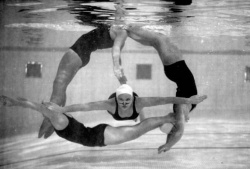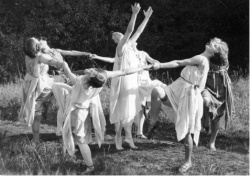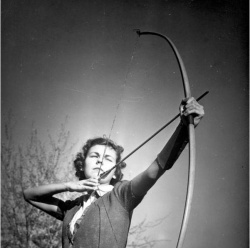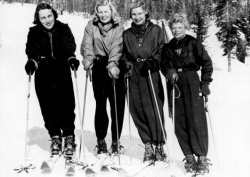Personal tools
Help
Class Notes
- Do you have news for fellow WSU alumni and other readers of Washington State Magazine? Send us your class note.
Our Story
written by alumni, faculty and friends.
NOTE: THIS IS A LEGACY SITE AND IS NOT REGULARLY MAINTAINED
Views
Their place in history
From Our Story
WSU women athletes made their mark
(by Hannelore Sudermann, Washington State Magazine, Fall 2007)
One day in 1948 four Washington State College students tugged on their white rubber swim caps, adjusted their nose plugs, and plunged into a cold swimming pool. Three of them locked together head to foot to form a vertical underwater ring, and the fourth swam through it toward a photographer who captured the maneuver on film.
Last year Ryli Clark '06 found that picture—one of a series of photos of the Fish Fans, WSC’s swimming club—and she was stunned. “At first I couldn’t tell what or where it was,” says the alumna who had just graduated from WSU with a degree in digital technology and culture. “But the more I looked at it, the more amazing it seemed.”Clark had discovered the image in WSU’s Department of Manuscripts, Archives, and Special Collections (MASC), where she held a one-year post combing through photographs from the University’s collections hunting for visual records of women athletes at WSU from 1900 to 2000. Thanks to a state grant for preserving women’s history, she was able to digitize and put online more than 300 of those photos.
At first, Clark wasn’t sure how she’d connect with the project, especially since she’s not particularly athletic. But once she started looking through the scrapbooks and collections, she was hooked. She found women laughing, smiling, running, jumping, and dancing. She uncovered thousands of images of a campus alive with activity. “I even came across a few sports I didn’t even know existed,” she says. Field ball, for example, seemed to be a big sport in the 1920s. The ball was soccer-size, but Clark knew the game wasn’t soccer. The athletes were obviously using their hands to catch and throw the ball.
Her curiosity moved beyond what these students did for exercise to the logistics of doing it. “I can’t imagine participating in sports wearing the clothes they did,” she says. “In the early years they had big wool pants, big bows, and big shirts.” On their feet, she saw old-fashioned, well-worn shoes and boots with no cushion and no arch support.
Clark had always thought of old photographs as being rather staid. But as she held the images of her classmates from earlier times, she thrilled to view a cluster of women from the 1920s clad in togas, linking hands, and throwing back their heads as they pranced in a circle; a group of women from the 1930s armed with foils, wearing loose knee-length gauchos, and fiercely fencing one another; and from the 1940s, students in long tweed skirts, standing daintily on the grass to practice their golf putts.As Clark sorted through the material, it struck her that the earliest photographs showed the widest range of activities: track, baseball, interpretive dance, basketball, archery, field hockey, and riflery. But later, in the ’50s and ’60s, the sports seemed to boil down to just a few, like gymnastics, bowling, and cheerleading. Clark wonders if the change had something to do with changing times and culture, or if photos of other sports just didn’t make it into the collections.
For a better understanding, she studied up on Title IX, a national gender equity law enacted in the 1970s and tested at WSU in the 1980s. The Pullman-based case, Blair v. WSU, resulted in a Washington State Supreme Court decision to provide student athletes in Washington equal support and facilities regardless of gender. That decision brought more funding for women’s sports and provided women with a greater variety of sports in which to compete.
But it may have been hard to match the sheer variety of activities from the earliest years of WSC when there was a real diversity of clubs and activities, says Trevor Bond, the special collections librarian who worked with Clark on the project. “It’s great to see that these things were on campus at one time, even if they aren’t around anymore.”
Many of the photos Clark included in the new digital collection came out of the University’s own archives of pictures shot by faculty, employees, and local studios. But others came from personal scrapbooks donated to the library by alumni, says Laila Miletic-Vejzovic, head of MASC and administrator of the state grant from the Washington Women’s History Consortium. The women’s history initiative, led by the Washington State Historical Society, is designed to preserve and make public the details of the history of women in Washington. The University is one of the technical partners in the initiative, and is eligible for state funding to delve into its archives, organize its documents relating to women’s history, and make it more accessible to the public.
The archivists are hoping that more alumni will connect with this collection, either by contributing some of their own images, or by providing details of the photos already on-line. When Miletic-Vejzovic visited a library donor in Oregon last spring, she happened to mention the Women’s Athletics project. The alumna, Barbara Brooks '78, mentioned that she had been in gymnastics at WSU. In fact, it was one of the things that attracted her to the school, she said. So Miletic-Vejzovic opened up the on-line database, and sure enough, a photo of Brooks’s team was there. “She was so happy to see it.” And she was happy to provide details about her fellow team members and the coach.That was good news to Clark, who would still like to know more about many of the photos she spent so much time with over the past year. “It would be great if more people came forward with their stories,” she says.
To view more photos of women athletes at WSU and learn more about the Washington Women’s History Consortium, click here.
Our Story site map
Our Story main page | Our Story categories | Help Desk
Contact | Give | Advertise
Washington State Magazine | Washington State University | Class Notes
Our Story is coordinated by
In partnership with
Our Story and Washington State Magazine are publications of Washington State University. All rights reserved.
P.O. Box 641227, Washington State University, Pullman, WA 99164-1227 USA | wsm@wsu.edu, 509-335-2388
Accessibility | Copyright | Policies




